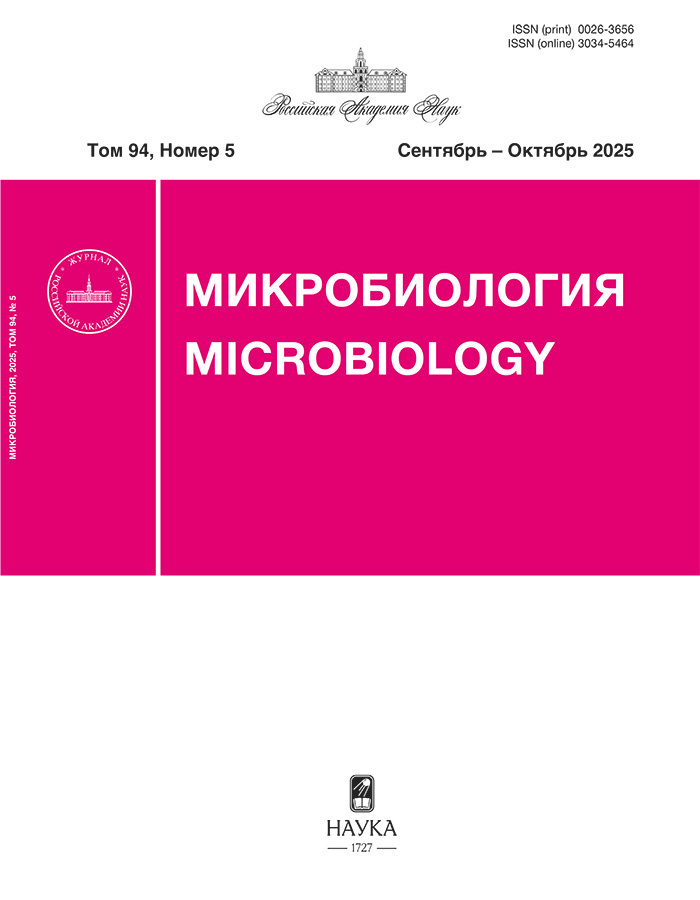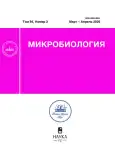Features of development of microscopic fungi in conditions of ultra-weak magnetic fields
- Authors: Rodimin V.D.1, Kharin S.A.1, Poddubko S.V.1, Kurakov A.V.2, Kulachkova S.A.2, Yarmeeva M.M.2, Lebedev V.M.2, Spassky A.V.2
-
Affiliations:
- Institute of Biomedical Problems of the Russian Academy of Sciences
- Lomonosov Moscow State University
- Issue: Vol 94, No 2 (2025)
- Pages: 145-156
- Section: EXPERIMENTAL ARTICLES
- URL: https://gynecology.orscience.ru/0026-3656/article/view/680836
- DOI: https://doi.org/10.31857/S0026365625020031
- ID: 680836
Cite item
Abstract
Abstract. The paper presents the results of a study of the effect of ultra-weak magnetic fields (MF) on the viability, growth characteristics, respiratory activity, and antagonistic properties of microscopic fungi. The experiments were conducted on strains isolated from the interior of the International Space Station. To create hypomagnetic conditions (HMC), the hypomagnetic chambers GMK-1 and GMK-2, shielding the Earth’s MF, were used in the experiments. The chamber walls are a two-section magnetic screen made of amorphous permalloy tape. In the experiments, the GMK chambers made it possible to reduce the geomagnetic field by 1000–2000 times. The maximum value of the MF after demagnetization did not exceed 45 nT. It was found that the hypomagnetic field (HMC) did not have a predominantly inhibitory and/or stimulating effect on the viability of spores and the growth of fungal colonies, as indicated by the absence of reliable changes in the quantitative level, percentage of spore germination and radial growth rate of the tested strains in the HMC compared to geomagnetic conditions. At the same time, the growth and respiration rate of micromycetes in some cases was significantly stimulated in the GMF during their development on the surface of samples of structural materials under conditions of limited availability of nutrients. It was also found that the GMF affects the antagonistic properties of some microscopic fungi. The Penicillium rugulosum 633.12 strain grown in the GMF completely lost its antagonistic activity towards bacteria, which was found to be high when cultivated under standard geomagnetic conditions. The results obtained are discussed in the context of the features of microbial colonization of the habitat of future lunar complexes.
Full Text
About the authors
V. D. Rodimin
Institute of Biomedical Problems of the Russian Academy of Sciences
Email: charin@imbp.ru
Russian Federation, Moscow, 123007
S. A. Kharin
Institute of Biomedical Problems of the Russian Academy of Sciences
Author for correspondence.
Email: charin@imbp.ru
Russian Federation, Moscow, 123007
S. V. Poddubko
Institute of Biomedical Problems of the Russian Academy of Sciences
Email: charin@imbp.ru
Russian Federation, Moscow, 123007
A. V. Kurakov
Lomonosov Moscow State University
Email: charin@imbp.ru
Faculty of Biology
Russian Federation, Moscow, 119234S. A. Kulachkova
Lomonosov Moscow State University
Email: charin@imbp.ru
Faculty of Biology
Russian Federation, Moscow, 119234M. M. Yarmeeva
Lomonosov Moscow State University
Email: charin@imbp.ru
Faculty of Biology
Russian Federation, Moscow, 119234V. M. Lebedev
Lomonosov Moscow State University
Email: charin@imbp.ru
Skobeltsyn Research Institute of Nuclear Physics
Russian Federation, Moscow, 119991A. V. Spassky
Lomonosov Moscow State University
Email: charin@imbp.ru
Skobeltsyn Research Institute of Nuclear Physics
Russian Federation, Moscow, 119991References
- Бинги В.Н., Савин А. В. Физические проблемы действия слабых магнитных полей на биологические системы // Успехи физ. наук. 2003. Т. 173. № 3. С. 265–300.
- Быстрова Е. Ю., Богомолова Е. В., Гаврилов Ю. М., Панина Л. К., Стефанов В. Е., Сурма С. В., Щеголев Б. Ф. Влияние постоянного магнитного и экранированного геомагнитного полей на развитие колоний микромицетов // Микология и фитопатология. 2009. Т. 43. С. 438–446.
- Викторов А. Н., Новикова Н. Д., Поликарпов Н. А., Горшков В. П., Константинова С. В. Актуальные проблемы микробиологической безопасности среды обитания орбитальных станций в условиях многолетней эксплуатации // Авиакосмическая и экологическая медицина. 1995. Т. 29. № 5. С. 51–55.
- Гудошников С. А., Венедиктов С. Н., Гребенщиков Ю. Б., Кузнецов П. А., Маннинен С. А., Васильева О. В., Криволапова О. Н., Труханов К. А., Круглов О. С., Спасский А. В. Экранирующая камера для ослабления магнитного поля Земли на основе рулонных магнитных материалов // Измерительная техника. 2012. № 3. С. 58–61.
- Касатова Е. С., Стручкова И. В., Аникина Н. А., Смирнов В. Ф. Действие слабого низкочастотного электромагнитного поля на активность экстрацеллюлярных оксидоредуктаз Trichoderma virens // Микология и фитопатология. 2017. Т. 51. С. 99–103.
- Легостаев В. П., Лопота В. А. Луна – шаг к технологиям освоения Солнечной системы. М.: РКК “Энергия”, 2011. 584 с.
- Макаров И. О., Клюев Д. А., Смирнов В. Ф., Смирнова О. Н., Аникина Н. А., Дикарева Н. В. Действие низкочастотного магнитного поля и низкоинтенсивного лазерного излучения на активность оксидоредуктаз и рост микромицетов – активных деструкторов полимерных материалов // Микробиология. 2019. Т. 88. С. 83–90.
- Makarov I. O., Klyuev D. A., Smirnov V. F., Smirnova O. N., Anikina N. A., Dikareva N. V. Effect of low-frequency pulsed magnetic field and low-level laser radiation on oxidoreductase activity and growth of fungi active destructors of polymer materials // Microbiology (Moscow). 2019. V. 88. P. 72–78.
- Панина Л. К., Богомолова Е. В., Гаврилова Ю. М., Дмитриев С. П., Доватор Н. А. Аномальный полярный рост мицелия в условиях “магнитного вакуума” // Микология и фитопатология. 2012. Т. 46. С. 81–85.
- Albertini M. C., Accorsi A., Citterio B., Burattini S., Piacentini M. P., Uguccioni F., Piatti E. Morphological and biochemical modifications induced by a static magnetic field on Fusarium culmorum // Biochimie. 2003. V. 85. P. 963–970.
- Belosokhov A., Yarmeeva M., Kokaeva L., Chudinova E., Mislavskiy S., Elansky S. Trichocladium solani sp. nov. – a new pathogen on potato tubers causing yellow rot // J. Fungi (Basel). 2022. V. 8. Art. 1160.
- Binhi V. N., Alipov Y. D., Belyaev I. Y. Effect of static magnetic field on E. coli cells and individual rotations of ion-protein complexes // Bioelectromagnetics. 2001. V. 22. P. 79–86.
- Binhi V. N., Prato F. S. Biological effects of the hypomagnetic field: an analytical review of experiments and theories // PLoS One. 2017. V. 12. Art. e0179340.
- Dubrov A. P. The geomagnetic field and life: Geomagnetobiology. New York City, USA. Springer, 1978. 318 p.
- Erdmann W., Kmita H., Kosicki J. Z., Kaszmarek L. How the geomagnetic field influences life on earth – an integrated approach to geomagnetobiology // Orig. Life Evol. Biosph. 2021. V. 51. P. 231–257.
- Nagy P., Fischl G. Effect of static magnetic field on growth and sporulation of some plant pathogenic fungi // Bioelectromagnetics. 2004. V. 25. P. 316–318.
- Moore R. L. Biological effects of magnetic fields: studies with microorganisms // Can. J. Microbiol. 1979. V. 25. P. 1145–1151.
- Novikova N. D., Pierson D. L., Poddubko S. V., Deshevaya Y. A., Ott C. M., Castro V. A., Bruce R. J. Microbiology of the International Space Station. In US and Russian cooperation in space biology and medicine / Eds. Sawin C. F., Hanson S. I., House N. G., Pestov D.I Reston, Virginia: American institute of aeronautics and astronautics, 2009. V. 5. 469 p.
- Obhođaš J., Valković V., Kollar R., Hrenović J., Nađ K., Vinković A., Orlić Ž. The growth and sporulation of Bacillus subtilis in nanotesla magnetic fields // Astrobiology. 2021. V. 21. P. 323–331.
- Panina L. K., Bogomolova E. V., Dmitriev S. P., Dovator N. A. Investigation of the structural reorganization of micromycetes in hypomagnetic fields // J. Phys. Conf. Ser. 2019. V. 1400. Art. 033016. https://doi.org/10.1088/1742-6596/1400/3/033016
- Pazur A., Schimek C., Galland P. Magnetoreception in microorganism and fungi // Cent. Eur. J. Biol. 2007. V. 2. P. 597–659.
- Ruiz-Gomez M.J., Prieto-Barcia M.I., Ristori-Bogajo E., Martinez-Morillo M. Static and 50 Hz magnetic fields of 0.35 and 2.45 mT have no effect on the growth of Saccharomyces cerevisiae // Bioelectrochem. 2004. V. 64. P. 151–155.
- Sinčák M., Sedlakova-Kadukova J. Hypomagnetic fields and their multilevel effects on living organisms // Processes. 2023. V. 11. Art. 282.
- Volpe P. Interactions of zero-frequency and oscillating magnetic fields with biostructures and biosystems // Photochem. Photobiol. Sci. 2003. V. 2. P. 637–648.
- White T. J., Bruns T. D., Lee S. B., Taylor J. W. Amplification and direct sequencing of fungal ribosomal RNA genes for phylogenetics // PCR Protocols: A guide to methods and applications / Eds. Innis M. A., Gelfand D. H., Sninsky J. J., White T. J. New York: Academic Press, 1990. P. 315–322.
Supplementary files













